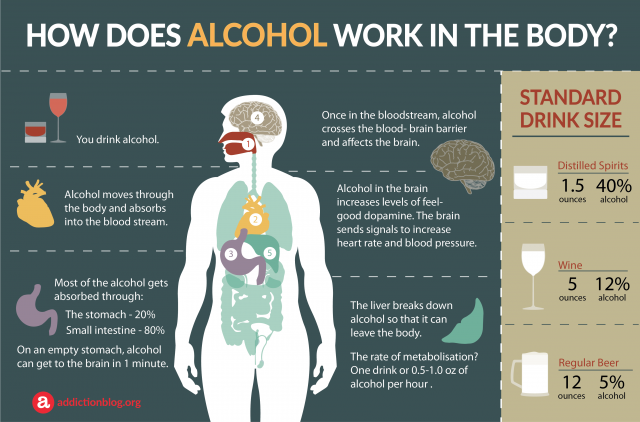Alcohol is not body-friendly
When you drink, you might feel relaxed, confident, and fun to be around. These pleasurable effects cant make it easy for you to push aside the negative consequences of drinking, such as:
- clouded thinking
- impaired motor functions
- poor judgement
- memory problems
- reduced coordination
- slowed reflexes
… and the list goes on…negative effects can even include problem drinking and alcohol addiction. One thing’s for certain: While you may find the effects of alcohol fun, your body doesn’t.

In this infographic, we outline how alcohol travels through the body from the first sip to the moment of elimination. Explore it to learn more about how alcohol works in the body. At the end, feel free to send us your questions and feedback. We value the comments of our readers and do our best to answer all legitimate inquiries personally and promptly.
How does alcohol work in the body?
1. First, you drink alcohol.
2. Then, alcohol travels from your mouth, through the esophagus, and enters the stomach.
3. Most of the alcohol gets absorbed through the stomach lining – 20%; and small intestine – 80%. Because of this, peak blood alcohol concentrations are achieved within 0.5 to 2.0 hours on an empty stomach, or in the average individual within 1.06 to 2.12 hours.
4. On an empty stomach, alcohol can get into the bloodstream and to the brain in 1 minute. But, first, it needs to cross the blood-brain barrier.
5. Alcohol in the brain increases levels of the feel-good neurotransmitter called dopamine. As a result, the brain sends signals to:
- increase heart rate and blood pressure
- slow down your reflexes
- reduce your inhibitions
- impair coordination
- fog out your sensations and perception
6. Alcohol is broken down and undergoes metabolism in the liver before it can leave the body. About 92-98% of alcohol is broken down and metabolized here.
7. Finally, the remaining 2-8% of alcohol are eliminated from the body through excretion in breath, urine, sweat, feces, breast milk and saliva.
Alcohol metabolism is important!
Q: At which rate is alcohol metabolized?
A: One drink per hour (0.5-1.0 oz of alcohol in 1 hour).
The rates of absorption, metabolization, and elimination are highly individual and depend on the drinker’s age, body mass, gender, physical health, level of hydration, whether you’ve eaten or not, and whether you are taking medications or illicit drugs along with alcohol.
Any Questions?
Still wondering about how alcohol works in your body? If you have any questions about the way alcohol works and travels through the human body, please feel free to post them in the designated section at the end of the page. We try to provide a personal and prompt response to all legitimate inquiries.
And…if you like our infographic, please SHARE!








Related Posts